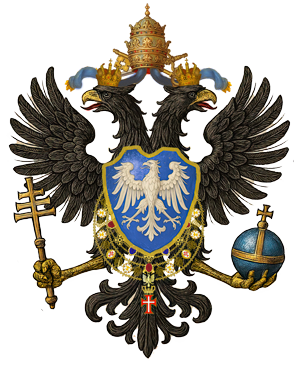|
The Holy Apostolic See
|
||||||||||||||
| The
Holy Apostolic See of the United Roman-Ruthenian Church is the true
visible Orthodox head of all Latin Christians, in addition to all
others under her sacred mantle of care. The Church serves as the
Orthodox Old Catholic jurisdiction for the historic lands of the
Western Patriarchate and Holy Rus’. We are the Eastern Roman Church with Latin heritage, the continuation of the Apostolic faith where East and West meet. Our mission is to preserve and renew the Orthodox-Catholic faith in its full inheritance. Read more at this article and this article. |

| MAIN PORTAL | History |
| Key Readings |
Apostolic
Household |
| Government | Pontifical Walsingham Guard |
| Pontifical Court |
Roman-Ruthenian
Papacy |
| Historical
Timeline |
Liturgy |
| Patriarchal Succession | Contact |

The Custodian of Apostolic Continuity and Orthodox-Catholic Unity
The United Roman-Ruthenian
Church and Pontifical Imperial State is a sovereign, autocephalous
patriarchal Church rooted in both Orthodox and Catholic tradition.
Emerging as a derivative patriarchate of Rome, Russia, Greece, and
America, it is an Eastern Roman Church with Latin heritage. The Church
stands not only as a symbol of ecclesial unity but as the rightful
temporal successor to St. Peter and spiritual successor to Pope St. Leo
X.

Declared by ecclesiastical decree and divine providence, the Roman-Ruthenian Pope-Catholicos, Radislav I, was quietly confirmed in 2014 as coadjutor to the Roman Pope by the Cardinal Dean, entrusted with full papal authority in the jurisdiction of the United Roman-Ruthenian Church. The results of this act slowly began to be revealed to the public in 2020. That confirmation was brought to full completion following the death of Pope Francis on 21 April 2025, the traditional founding date of Rome and the very day on which Radislav had been sacramentally confirmed into the Roman Church decades earlier. The convergence of these dates is not coincidence, but a divinely providential realignment.

H.A.H. Pope Radislav I of Rome-Ruthenia at the Memorial Church, Harvard University
The Roman-Ruthenian Church affirms itself as the rightful temporal successor of St. Peter, carrying the historical and documented patrimony of Rome and Russia through St. Leo X, with full Orthodox and Catholic autocephalous authority — equal to the Vatican, Constantinople, and other Patriarchates. It is the guardian of Latin Orthodoxy, the bridge between East and West, and the visible head of the Latin tradition in fidelity to the Orthodox and Catholic faith.

The Church’s mission does not seek civil rule. It is neither territorial nor expansionist, but custodial, protecting the undivided Church’s theological, liturgical, and cultural legacy. It embraces the harmony of conciliar Orthodox Christianity, integrating East and West without compromise or syncretism. From its Byzantine rites and Syriac influences to its Latin liturgy and apostolic governance, it serves as a living witness to the pre-Schism Church.

Indeed, the United Roman-Ruthenian Church does not oppose the existence of other churches, nor seek to dominate their structures. Rather, it offers itself as a sanctuary of continuity for those dislocated by theological rupture, ecclesiastical scandal, or spiritual displacement. In doing so, it fulfills not a partisan ambition, but a providential necessity.
As Radislav I of Rome-Ruthenia declares:

Declared by ecclesiastical decree and divine providence, the Roman-Ruthenian Pope-Catholicos, Radislav I, was quietly confirmed in 2014 as coadjutor to the Roman Pope by the Cardinal Dean, entrusted with full papal authority in the jurisdiction of the United Roman-Ruthenian Church. The results of this act slowly began to be revealed to the public in 2020. That confirmation was brought to full completion following the death of Pope Francis on 21 April 2025, the traditional founding date of Rome and the very day on which Radislav had been sacramentally confirmed into the Roman Church decades earlier. The convergence of these dates is not coincidence, but a divinely providential realignment.

H.A.H. Pope Radislav I of Rome-Ruthenia at the Memorial Church, Harvard University
The Roman-Ruthenian Church affirms itself as the rightful temporal successor of St. Peter, carrying the historical and documented patrimony of Rome and Russia through St. Leo X, with full Orthodox and Catholic autocephalous authority — equal to the Vatican, Constantinople, and other Patriarchates. It is the guardian of Latin Orthodoxy, the bridge between East and West, and the visible head of the Latin tradition in fidelity to the Orthodox and Catholic faith.
A Church, a State, a People
The Pontifical Imperial State of Rome-Ruthenia, a non-territorial ethno-religious nation without border, complements the United Roman-Ruthenian Church’s mission. It preserves the cultural, legal, and spiritual heritage of the Roman Empire, the Holy Roman Empire, Old Rus’, and the Holy Apostolic See of Saints Peter, Andrew, Stephen, and Mark.
The Church’s mission does not seek civil rule. It is neither territorial nor expansionist, but custodial, protecting the undivided Church’s theological, liturgical, and cultural legacy. It embraces the harmony of conciliar Orthodox Christianity, integrating East and West without compromise or syncretism. From its Byzantine rites and Syriac influences to its Latin liturgy and apostolic governance, it serves as a living witness to the pre-Schism Church.

Indeed, the United Roman-Ruthenian Church does not oppose the existence of other churches, nor seek to dominate their structures. Rather, it offers itself as a sanctuary of continuity for those dislocated by theological rupture, ecclesiastical scandal, or spiritual displacement. In doing so, it fulfills not a partisan ambition, but a providential necessity.
A Voice for the Faithful
To the disillusioned, the traditional, and the faithful, clergy and laity alike, the United Roman-Ruthenian Church offers this message: the Apostolic Church is not lost. The truth endures.As Radislav I of Rome-Ruthenia declares:
“We
do not claim perfection. We claim only what was given to us: the
keys, the cross, and the promise that the gates of hell shall not
prevail.”





The immediate patriarchal ancestors of in apostolic succession
of the Roman-Ruthenian Pope:
Patriarchs Sergei of Moscow, Mar Yousef VI Emmanuel II of Babylon (Syrian), Damian I of Jerusalem, and St. Aftimios of America (one of the two Holy Fathers of the Holy Apostolic See). The United Roman-Ruthenian Church is a derivative patriarchate of these Russian, Syrian, Greek, and American patriarchates, as well as Rome as rightful temporal successor of St. Peter.



Official Website of the United Roman-Ruthenian Church and the Pontifical Imperial State of Rome-Ruthenia
(also referred to as the Roman-Ruthenian Church and State)
Please be advised: any website or entity not listed below, or any unauthorized use of the names, titles, or symbols associated with the Roman-Ruthenian Church and State, is unofficial and not affiliated with the legitimate and singular Roman-Ruthenian Church and State.
Official Websites of the Church:
www.statopontificio.org
www.pontificalstate.org
www.catholicate.org
www.ilnunzioromano.org
Official Websites of the Prince-Bishop:
www.radislav.org
www.rutherfordjohnson.com
www.statopontificio.org/johnson-roma-rus


